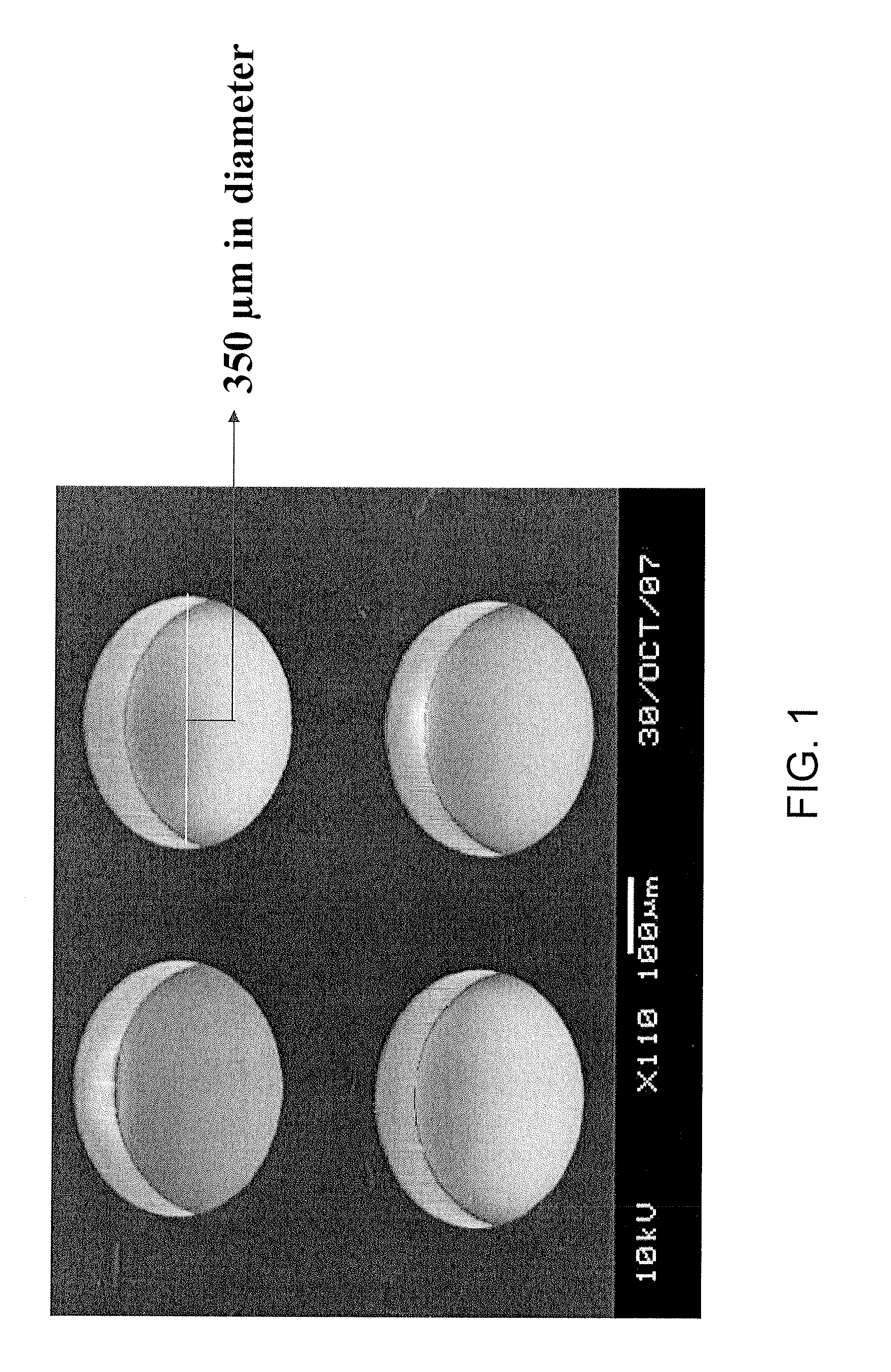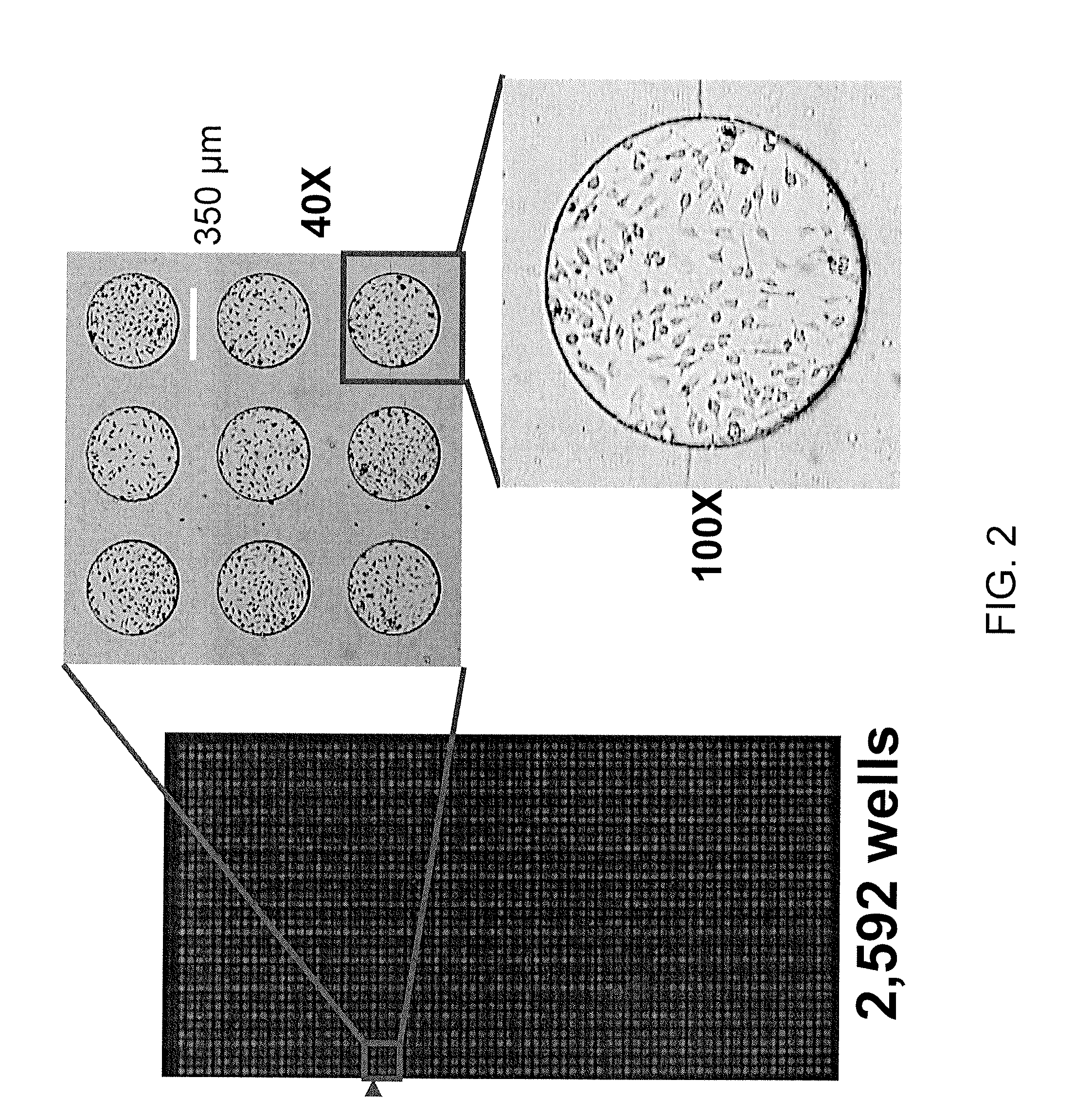Microarray chip and method of fabricating for the same
a microarray and chip technology, applied in the field of microarray chips, can solve the problems of poor adhesion of resist material currently used in the preparation of microarray systems, inability to provide reliable experimental results, and the inability to conduct assays using such a microarray system
- Summary
- Abstract
- Description
- Claims
- Application Information
AI Technical Summary
Benefits of technology
Problems solved by technology
Method used
Image
Examples
example 1
Array Chip Fabrication Using a Quartz Wafer
[0072]Quartz wafer was cleaned according to a Piranha Clean procedure as suggested (http: / / engineering.tufts.edu / microfab / index_files / SOP / PiranhaClean_SOP.pdf), and dried prior to coating with the photoresist material. The quartz wafer was then placed on a TEFLON™ carrier and submerged in a bath of 96% H2SO4:30% H2O2 solution (1:1) for 10-20 minutes to remove all organics. Next, the quartz wafer was removed from the bath and rinsed in deionized (DI) water for 15 minute. After the Piranha clean, the quartz wafer was blown dry with nitrogen or dried in an oven at 120° C. or on a hotplate at 150° C. and placed in a carrier box until ready for coating.
[0073]Commercially available photoresist material such as SU-8 100 film (MicroChem, Newton Mass.) having a thickness of about of 100 μm was spin-coated on the quartz wafer according to the coating conditions described as follow. During a spread cycle the wafer was ramped to 500 rpm at an accelerat...
example 2
Array Chip Fabrication Using a Glass Wafer
[0075]Glass wafer was cleaned by a Piranha clean procedure as described above and dried prior to coating with the photoresist. The glass wafer was then placed on a TEFLON™ carrier and submerged in a bath of H2O:H2O2:NH4OH solution (5:1:1) for 10 minutes. Next, the glass wafer was removed from the bath and rinsed in deionized (DI) water for 1 minute. The glass wafer was further submerged in a bath of H2O:HF solution (50:1) for 15 seconds and rinsed in the DI water for 1 minute. The glass wafer was submerged in a bath of H2O:H2O2:HCl solution (6:1:1) for 10 minutes and rinsed in DI water for 1 minute. After the RCA clean, the glass wafer was blown dry with nitrogen and placed in a carrier box until ready for coating.
[0076]Commercially available photoresist such as SU-8 3050 film (MicroChem, Newton Mass.) having a thickness of about 100 μm was spin-coated on a glass wafer according to the coating conditions described as follow. During a spread ...
example 3
Array Chip Fabrication Using a Silicon Wafer
[0078]Silicon wafer was cleaned by a Piranha clean procedure as described above and dried prior to coating with the photoresist. The silicon wafer was then placed on a TEFLON™ carrier and submerged in a bath of H2O:H2O2:NH4OH solution (5:1:1) for 10 minutes. Next, the silicon wafer was removed from the bath and rinsed in deionized (DI) water for 1 minute. The silicon wafer was further submerged in a bath of H2O:HF solution (50:1) for 15 seconds and rinsed in the DI water for 1 minute. The silicon wafer was submerged in a bath of H2O:H2O2:HCl solution (6:1:1) for 10 minutes and rinsed in DI water for 1 minute. After the Piranha clean, the silicon wafer was blown dry with nitrogen and placed in a carrier box until ready for coating.
[0079]Commercially available negative tone photoresist such as SU-8 50 film (MicroChem, Newton Mass.) having a thickness of about 50 μm was spin-coated on a glass wafer according to the coating conditions describe...
PUM
| Property | Measurement | Unit |
|---|---|---|
| thickness | aaaaa | aaaaa |
| diameter | aaaaa | aaaaa |
| thickness | aaaaa | aaaaa |
Abstract
Description
Claims
Application Information
 Login to View More
Login to View More - R&D
- Intellectual Property
- Life Sciences
- Materials
- Tech Scout
- Unparalleled Data Quality
- Higher Quality Content
- 60% Fewer Hallucinations
Browse by: Latest US Patents, China's latest patents, Technical Efficacy Thesaurus, Application Domain, Technology Topic, Popular Technical Reports.
© 2025 PatSnap. All rights reserved.Legal|Privacy policy|Modern Slavery Act Transparency Statement|Sitemap|About US| Contact US: help@patsnap.com



